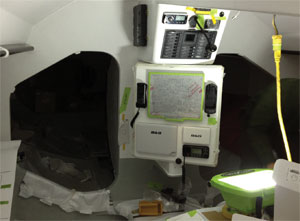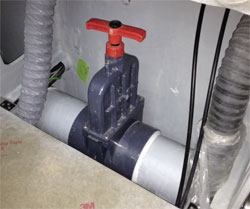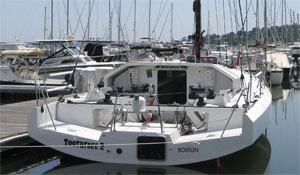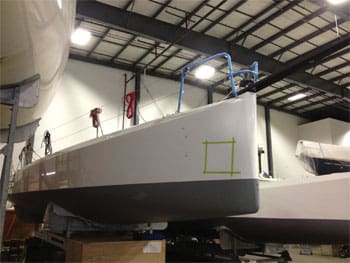The pressure of competition often pushes forward overall boat design and system development. Though high-end sail racing machines seem to bear little resemblance to voyaging boats, the results of racing’s rapid development cycles often find their way into the hands of cruisers.
One racing class undergoing this rapid development cycle are the Class 40 boats. The U.S. importer for Class 40s is Akilaria Import LLC, which does its commissioning work at Maine Yacht Center (MYC) in Portland, Maine. These Class 40 boats are an international effort. The hulls and decks are built in Tunisia, the masts are produced in Romania and the keels and rudders originate in France.
Brian Harris, president of Akilaria, and a boatbuilder with more than 10 years of experience in open class boats, oversees the integration of hull, deck, keel, rudder and rig, as well as many other pieces of gear into a powerful race boat. Harris admits these boats are less about romantic notions of the beauty of sail than they are about industrial-strength, go-fast “racing machines.”
 |
|
The navigation console is mounted under the mast and can pivot to either side. |
 |
|
The main water ballast transfer pipe on the Akilaria Class 40s is much larger in diameter than those found on earlier models, allowing for faster tacks. |
The Class 40 boats come in two flavors: standard and RC3 versions. The two boats under assembly at MYC were both RC3s. This extension of the Class 40 is rated as an ORC Category 0 offshore race boat, meaning an RC3 has to be ready for “Trans-oceanic races, including races which pass through areas in which air or sea temperatures are likely to be less than 5 degrees Celsius other than temporarily, where yachts must be completely self-sufficient for very extended periods of time, capable of withstanding heavy storms and prepared to meet serious emergencies without the expectation of outside assistance.”
One way the Class 40 hulls meet this requirement is with five watertight compartments that can be sealed off via watertight doors. Another method is to use buoyant foam in many of the vessel’s empty spaces. With added buoyancy and with watertight bulkheads, the Class 40 boats are designed to withstand some level of hull damage and still stay afloat. The reason for this is clear in the Category 0 description above. The boat and its driver may find themselves in situations where there is little to no chance of outside assistance.
Still, even though they must be tough to withstand tough conditions, Class 40s are still lightweight race boats designed to go fast. Sitting on the 40-foot hull is a 62-foot carbon fiber mast that can carry more than 2,800 square feet of sail. And that rig is driving a 40-foot hull weighing in at 9,900 pounds (4.9 tons). A 37-foot Island Packet 370, by comparison, has a standard displacement of 23,800 pounds (11.9 tons) with a 54-foot tall mast.
Even for a class as young as the Class 40s, there has been plenty of small design changes to produce ever faster boats. The overall hull shape of the Class 40 is similar to the Open 60s pioneered for the Vendée Globe and other shorthanded round-the-world races: plumb bow and narrow entry that widens to flat sections aft. This design gives the boat substantial form stability aft, which is further augmented in the bigger boats by canting keels that can get the keel bulb well out to windward. The Class 40 boats are prohibited from using canting keels. Instead, they use a deep fixed keel ballast bulb.
 |
|
A nearly complete Class 40 in the water at Maine Yacht Center after launching. |
Harris and crew are putting together some of the incremental changes designers are using to squeeze even more speed from these sleds. Harris pointed out that while the first versions of Class 40s had a right angle at the gunwale where the hull meets the deck, the Class 40 boats now have eliminated that right angle for a flat area that joins the hull and deck — as if that gunwale corner had been shaved off. The idea is simple: less hull material means less weight and thus a better power to weight ratio.
The Class 40s make use of water ballast for stability, with two ballast tanks, one on either side of the hull. Experience with the water ballast on Class 40s and other classes of race boats has led to refinements in the way the water is handled. Older vessels used smaller transfer pipes, but racers found that the smaller pipe impeded flow and meant that transferring water ballast between tanks took longer than desired. The present Class 40s, on the other hand, have a wide, six-inch diameter main transfer pipe that can move water between tanks much faster and thus speed up the time required to complete a tack.
Even the spartan interiors of these boats have become more spare. For the nav station, previous Class 40s used a gimbaled chair and desktop that adjusted as a single unit when the vessel heeled. This arrangement has been superseded, however, by a nav pod mounted on a vertical pivot below the mast. Racers can pivot this pod to port or starboard. And instead of a fixed seat, the new Class 40s have an oversized bean bag that the race crew are free to reposition depending on heel, etc., to get the most comfortable arrangement. The result is a reduction in weight, allowing the boat to go faster.
Some of these design ideas may find their way to voyaging boats in one form or another. Or they may become design dead ends (it’s hard to imagine cruisers giving up berths for a bean bag!). When and if these design ideas are adopted, you can be sure that the race boat designers will be on to the next fastest thing.

